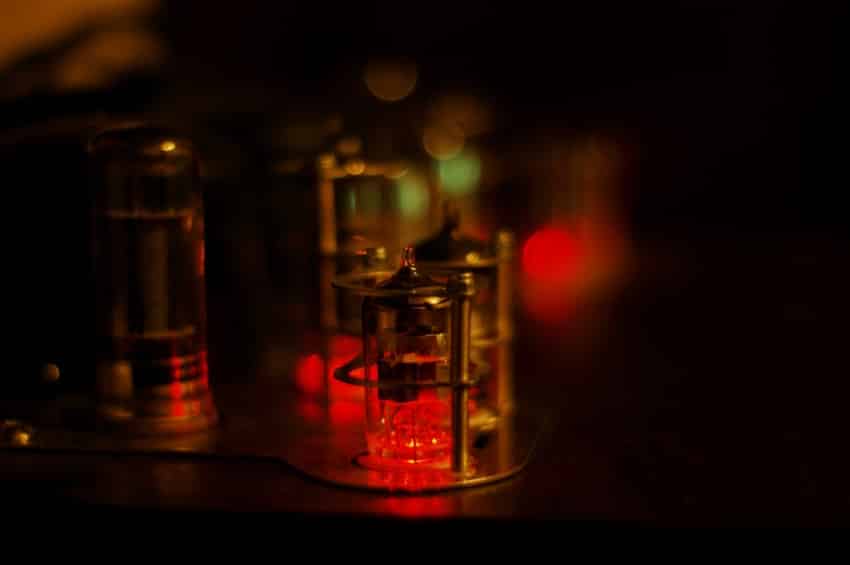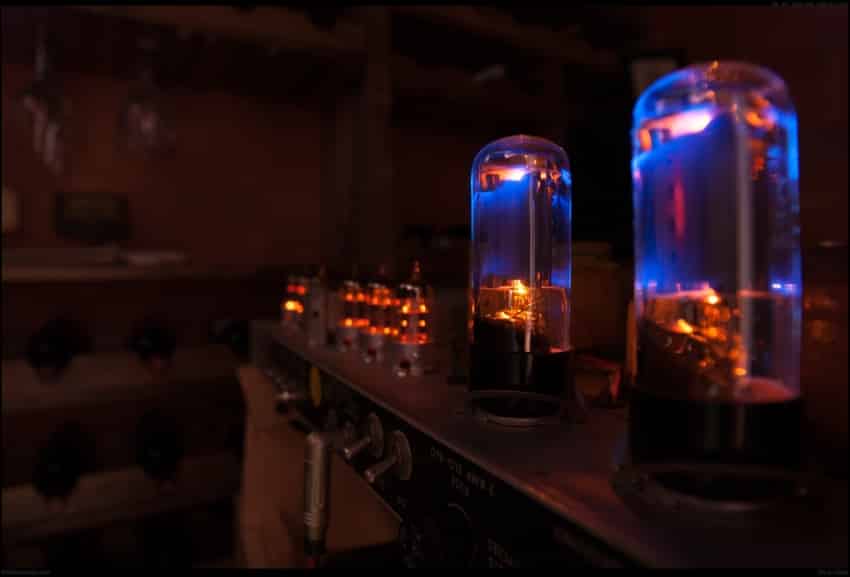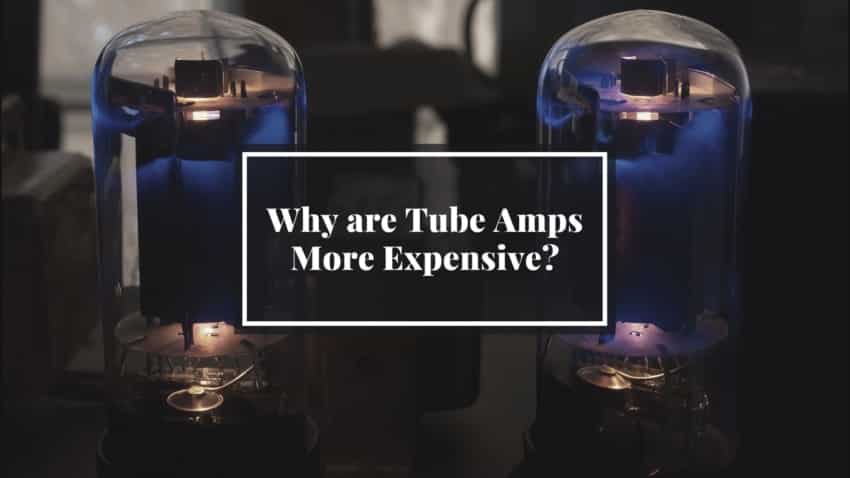Last updated on February 12th, 2021 at 01:25 pm
Ever wonder why everyone says that tube amps sound better, louder, and warmer?
Not only that, but they seem to be much more expensive than solid state amps, right?
Why is this?
Well, in this post I’ll try and answer all of these questions as best I can…
Let’s get started!
Here’s the short answer;
Tube amps are more expensive because the components used to build them cost more.
Each tube costs roughly $50 and there can be up to 4 of them within a single unit.
The cases are larger in order to create better airflow to help keep all of the components cool, the circuitry is far more complex, and more man-hours are required to build them.
Now, let’s go over these things in more detail.
Why are Tube Amps so expensive?

For a tube amp to work, it has to have a pre-amp as well as power amp tubes.
Each pre-amp tube costs roughly thirty dollars, whereas a power amp costs approximately sixty dollars.
Keep in mind that a tube amplifier will require four sets of each installed hence making it expensive.
Another essential tube component is the output transformer, which is even more costly than the pre-amp and power amp tubes.
These transformers carry the voltage to the amp’s speakers and go for about a hundred dollars each.
Designing tube amplifiers is an intricate process that requires more raw materials compared to solid-state amplifiers.
Firstly, these tube amps require a much bigger chassis, which is very costly.
Secondly, other components such as the tube amps, are delicate hence need more care during design to avoid damage, especially during transportation.
Thirdly, there must be adequate room in the amplifiers for components to cool.
These tube amps have point-to-point wiring and not circuit boards.
This means that a person has to run wires as well as clip the leads manually, and this could take up to three days of labor compared to fifteen minutes if the amplifiers were using circuit boards.
The manufacturing process requires more labor, more components, and circuitry, which is why these amplifiers are sold at a very high cost.
A tube manufacturing company may spend close to $400 hundred dollars to produce one tube amplifier, and they make a profit by selling it at thrice the amount used, causing a consumer to spend $1.200 just to get their hands on this equipment.
Other factors to consider may include the country of manufacture; If your tube amplifiers are manufactured in western countries and not in countries like China, they will cost more due to higher production costs. Moreover, big brands such as Fender and Marshall are on the pricier side.
The tube amp price also depends on whether the amplifier is custom made or mass-produced; Custom made amplifiers are also more expensive due to the excellent tube amp quality and more person-hours that they require.
Unlike before, there are very few companies manufacturing tube amps, and this is why this equipment is more expensive. Tube amps are also more massive than other amplifiers hence bulkier and are best for home use.
Why Tube Amps Sound Better

There are many reasons why artists swear by tube amps even though solid-state amps are more advanced, cheaper, and easily accessible.
Unlike solid-state amplifiers, tube amplifiers produce a “harmonic” distortion, which is relatively musical.
Distortions from tube amps create a higher octave of the same sound, usually of a second order, which is why they sound musical.
The harmonic bit is because unlike solid-state amps, the distortion from tube amps sounds more natural and pleasant.
An experiment by David Keeports, a professor from Mills college, revealed that an overdriven tube amp had dominant and even harmonics while the solid-state amp created odd harmonics.
Additionally, tube amplifiers have a progressive distortion and can mimic the sound coming from other instruments such as the piano.
If you press the piano keys more profoundly, the tube amplifier can pick that up and adjust its distortion.
For instance, the Woo WA7 tube which has excellent volume control and relays clean and smooth sounds depending on the type of signal and headphones used.
Tube amplifiers require reasonable power watts ranging anywhere between 8 and 80 watts to perform well.
This is in contrast to solid-state amps, which have an unreasonable wattage of up to 300 watts and wide sound range.
This feature makes them inefficient, especially among home users who only require low watts since they don’t plan on holding a concert from their living rooms.
In addition to this, unlike solid-state amplifiers, tube amplifiers clip gradually, and you can tell that from their even waveforms, and this soft clipping ensures that your tweeter speakers don’t blow out.
Tube amplifiers use film capacitors, which are better for coupling audio. The most common film capacitors used in tubes are made from polyester, which is optimum for decoupling direct-current (DC) voltages.
Unlike crown amplifiers, tube amps have a robust linear transfer function, hence less negative feedback, and one can tell just by looking at the distortion curves as well as the output impedances.
Tube amps are better than solid-state equipment because they have no DC leakage; DC leakage, however small it may be, can distort speakers as well as displace the woofer cone.
Tube amps have isolated outputs that allow you to connect the wires in parallel or series depending on the desired impedance, and traditional rock bands prefer tube amps because these tube amps often give off a ‘spongy’ feel, which then produces vintage sounds.
If you are an audiophile and are considering buying a tube amplifier, you may want to try any of the following brands:
The first tube amplifier being the California (Tone Research) SET-5.
One of its pros is its simplicity, which does not compromise the tube amp quality. It not only contains quality components but also has a vent for cooling.
The Fender Blues Junior III is another popular tube amplifier, especially among beginners. It produces excellent sound and is also easy to use.
Other good tube amps include the Peavey ValveKing II Micro-head, the Bugera V5 Infinium, and the Blackstar HT1R Series.
It all comes down to preference and the type of music being played.
Today more artists are going for the hybrid tube amplifiers that give a modern feel without fully compromising on the ancient tube sound.
Some users often compare tube amps to vintage cars.
Using this analogy could explain why tube amps are expensive; Vintage cars are rarer today, hence the demand is higher than the supply, which makes them more expensive.
Unpopular opinion from some artists is that tube amps are not necessarily better and that this is just a belief that has been passed over by older generations that have grown up using tube amps.
This notion, however, cannot be verified, therefore based on evidence, tube amps do sound better than solid-state ones.
Are Tube Amps Louder?
Yes, tube amps are louder, and there are several reasons why:
So, let’s say that you have two amplifiers, one solid-state and the other a tube amplifier, and both are of 50 watts. If you drive both amps at 50 watts, they’ll sound relatively similar.
However, any drive beyond their maximum power will result in sudden clipping of the solid-state amplifier.
The tube amplifier, however, will clip gradually, and the distortion will also increase without compromising the sound quality.
Note that solid-state amps use transistors, whereas tube amps have valves.
This is why the tube is considered louder because pushing it beyond the maximum only distorts it, but it’s able to drive more watts beyond the 50 limits.
Additionally, if you look at the tube amplifier’s compression on a guitar instrument, you’ll notice that a tube amp matches the transient attack coming from the guitar smoothly.
It then brings up the euphonic tones from the guitar, which makes it sound louder.
In short, tube amps can produce up to 90% power regardless of the signals being produced by a guitar. While the solid-state amps will clip hence producing less power.
Besides looking at the solid-state amp and tube amp from an equal wattage perspective, their respective components also count for why the tube amps are considered louder.
The speaker efficiency in tube amps is better than in solid-state amps.
If you compare the Celestion Vintage 30, which has 100 decibels/watts and the Celestion Rocket 50(95 decibels/watts), you notice there’s a difference of 5 decibels(dB).
The human ear will, therefore, perceive the rocket 50 to be louder.
Additionally, tube amps have output transformers that match not only the high impedance tube output but also tappings that allow these amps to match any signal.
Solid-state amps lack these transformers, which makes them less efficient when plugged into a speaker with a higher impedance.
As mentioned earlier, tube amps require more expensive components, which makes all their parts more efficient.
The complex circuits and capable speakers make any tube amp sound louder than a solid-state amp.
Why Tube Amps Sound Warmer

Tube amps have a way of reproducing noise.
According to audio terms, there are three forms of noise:
The first feature is referred to as interference. Interference includes microphonics, cable modem chatter as well as hum.
Interference is, in essence, human-made, which means that one can reduce this by following sound engineering practices.
The second characteristic of noise is called distortion, which is produced as a result of the non-linear aspects of audio equipment.
There are two types of distortion, namely harmonic or clipping.
As mentioned earlier, clipping happens when the amplifier exceeds its limit and fails to produce the intended sound.
The third feature is known as thermal noise, which is caused by the vibration of electrons found in the conductors.
Vacuum tube amplifiers can reproduce the noise that is present between musical notes, which is what audiophiles refer to as having a warmer sound.
The warm sound is due to some of the characteristics found in tube amps.
These amps regulate the thermal noise by controlling the voltage on the grid.
This is the complete opposite of how a solid-state amp works.
In a solid-state amp, the current flowing between the collector and emitter is controlled by a transistor.
Note that this control factor is a direct-current effect and not a voltage effect like in tube amps.
Solid-state amps, therefore, require transistor currents for amplification, which end up modifying the background noise.
This is unlike tube amps, which are amplified by voltage; hence they retain their statistical properties meaning they produce a natural sound, and consequently the warmth.
Additionally, tube amps have microphonics, which creates an extra reverberation, hence creating a warmer sound.
For instance, the Vox AC30 tube amp, which distorts faster as you increase the volume, thus giving off a warm tone.
Another reason why tube amps are perceived to produce a warmer sound is pegged on their distortion.
When solid-state amps distort, they produce odd harmonics, which are often third-order or even higher, whereas tube amps produce second-order even harmonics.
This is probably why many artists do not object to the distortions caused by tube amps and also go-ahead to call them warm.
Conclusion
Which amp you prefer certainly depends on your own taste.
The great thing about solid-state amps is that they are much more affordable, and one could say that they are better price-performance wise, but I don’t think, at least for now, that they can beat the warm tones of a tube amp.
Now, are you looking for ways of learning guitar from home without having to travel an hour to your teacher/school? I wrote a post about the best websites that you can use to learn guitar online that you should absolutely check out.
I hope this information was useful!
Have a wonderful day!
